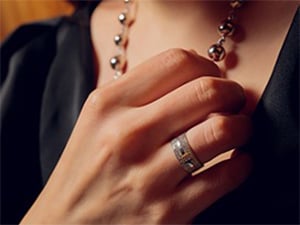- Home
- Blog
Jewelry 101: The Details Behind the Dazzle

Have you ever wondered why some pieces of jewelry seem to tarnish more than others? Or what that “14K-gold plated” description means on the necklace you ordered?
These are common questions, and at Thumbies, our jewelry experts love sharing their knowledge with curious customers almost as much as they love crafting new pieces of jewelry.
Little details, after all, make a big difference when it comes to jewelry and we want our customers to understand the work that we put into every pendant, ring and bracelet – not to mention earrings, cufflinks, pins and other items. The more you know about jewelry, the more you can appreciate the craftsmanship behind our one-of-a-kind pieces.
And as beautiful as it may be, it wouldn’t be a Thumbies’ piece if all it did was look good. Every Thumbies item is a keepsake that carries a profoundly felt, and uniquely personal memory. That’s why durability and design are important factors. With proper care, your Thumbies piece is designed to provide years of comfort and beauty.
Read on to learn more about the role of plating and other techniques for minimizing jewelry tarnish. And be sure to check back for more in our series of “Jewelry 101” educational blogs where we will address the topics and questions that are the most frequent source of questions from our customers.
To Tarnish or Not to Tarnish
Let’s start with tarnish. What is it, exactly? Tarnish is, simply put, a thin layer of build-up that develops on the surface in the form of a dark-colored film or veneer. It’s the byproduct of a chemical reaction between a metal and a non-metal compound, commonly (and in the case of your jewelry), oxygen and sulfur dioxide. In those terms, tarnish is a metal oxide, which is the result of a metal combining with air.
Precious metals, like gold and platinum, do not tarnish. But most metals do, including copper, brass, and aluminum. And when speaking of jewelry, most tarnish concerns arise around silver, which can tarnish over time.
“If your sterling silver piece is stamped as 925, that means that it’s 92.5 silver and the remaining percentage is a copper mix,” says Thumbies Senior Jewelry Expert Bret Dougherty. Copper strengthens the metal alloy.
Chemistry and Keepsakes
Tarnishing of silver jewelry is subject to many factors, including individual body chemistry, how and where a piece of jewelry is worn and how it is cared for. A quick polish from time to time can help keep jewelry looking new, similar to the shine on the family silver after polishing for a special occasion.
“Some people can wear a piece all the time, with little tarnishing,” Dougherty says. “Body oil and friction can reduce tarnishing.” This is why rings often stay fairly well polished. “Every time you grab something, you are polishing that ring.”
Dangling earrings, on the other hand, are less likely to be polished with wear, although in contact with cosmetics containing iron oxide, an earring that rubs against the wearer’s face may lose a bit of its tarnish coating. A pendant that lays against your skin may tarnish less than one that hangs over your clothes.
Diet can introduce another factor: your body chemistry. The more acidic your diet, the more your silver jewelry may tarnish. Unlike rust, however, tarnish does not corrode the underlying metal and can be easily removed to reveal the shiny silver surface beneath.
What the Plate?
Plating, which uses an electrical current to bond a layer of new metal to the surface, works to inhibit tarnishing. But plating has other benefits as well and at Thumbies, our proprietary plating process can actually prevent tarnishing while also improving both the durability and beauty of the pieces we create.
Our founder Tom Dougherty has seen Thumbies pieces that have remained untarnished for 40 years, except in places where the metal has been scratched through the layers of plating.
“We do all of our plating in-house,” Bret Dougherty says. “It’s a fairly standardized process, but the nuances are proprietary. We’ve plated more than a million pieces and we just spend more time … meaning that it’s thicker and more durable as a result.”
That’s not a small thing when it comes to creating a piece that is equal parts solace and jewelry. When you purchase a piece of Thumbies jewelry, you are investing in a memory you can pass on.
Still curious? Give us a call or click on the link below to learn more. You can also email us at info@thumbies.com to suggest topics for a future blog.
Recent Posts
Tags
- memorial keepsake (18)
- memorial jewelry (15)
- thumbprint keepsake (13)
- fingerprint jewelry (10)
- buddies (9)
- company update (8)
- custom jewelry (8)
- holiday gifts (8)
- pet keepsakes (8)
- cremation jewelry (7)
- thumbies (6)
- thumbuddies (6)
- Morris V. Prout (2)
- The Messenger Company (2)
- therapy animals (2)
- Pets With a Punch Card (1)
- clover (1)
- dougherty enterprises (1)
- employee development day (1)
- funeral home (1)
- st. patrick's day (1)
- ultimate canine (1)
Archives
- November 2020 (3)
- December 2020 (3)
- May 2021 (3)
- October 2020 (2)
- March 2021 (2)
- June 2021 (2)
- July 2021 (2)
- June 2022 (2)
- March 2024 (2)
- September 2020 (1)
- January 2021 (1)
- April 2021 (1)
- September 2021 (1)
- November 2021 (1)
- February 2022 (1)
- April 2022 (1)
- May 2022 (1)
- September 2022 (1)
- November 2022 (1)
- December 2022 (1)

